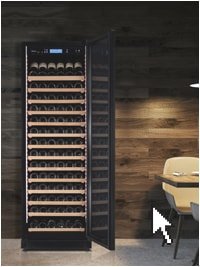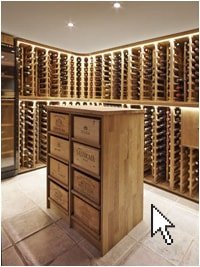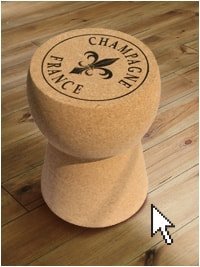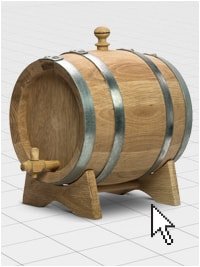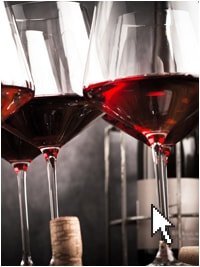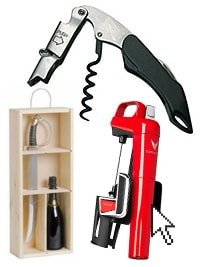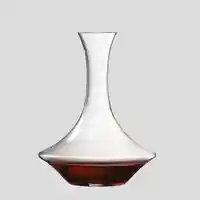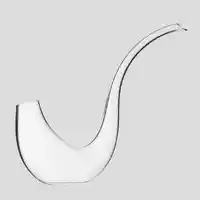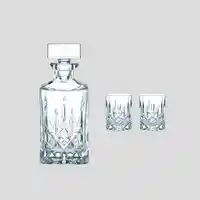Carafes
The nicest decanters and carafes in crystal. Find the ideal decanter to aerate or decant your wine.
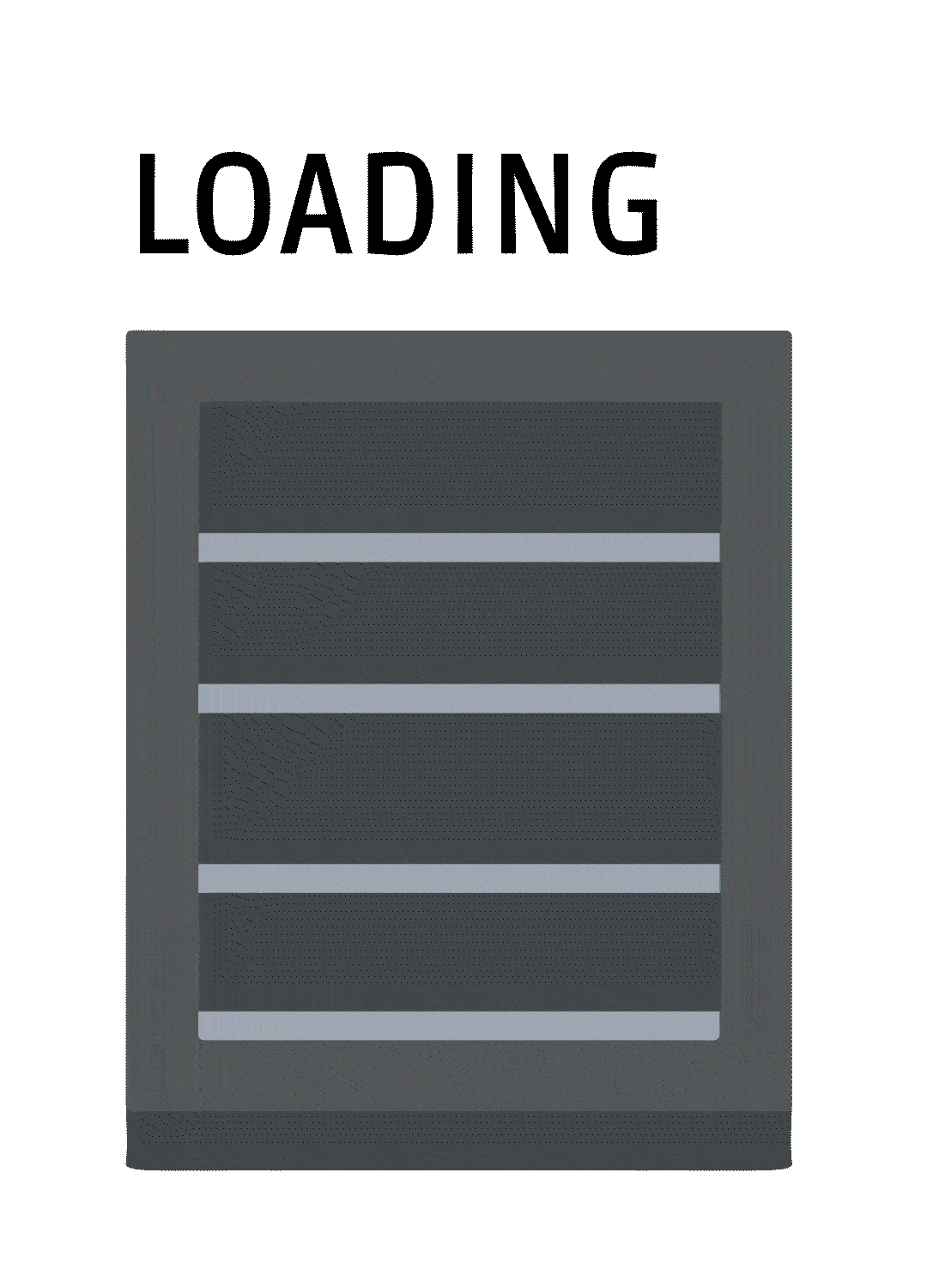
The decanter is a piece of equipment as much as a decorative object.
A wine decanter is mandatory in the tool box of every wine lover. A good decanter improves your wine experience significantly. You can aerate your wine. You can decant your wine. And on top of this a decanter looks great on any well-set table.
The range of decanters and carafes at Wineandbarrels.com is very wide. There are works of mouth blown sculptural art and minimalist designed carafes that will also look great as a water carafes.
It can be a bit tricky to keep track of all the dos and don?ts when using a decanter. What does aeration mean? And what is the difference between aeration and decantation? And does the difference mean anything?
What does decanting mean?
When separating the wine from its sediments a decanter is very useful. Open your wine bottle, tilt the decanter at a slant and pour the wine gently from the bottle into the decanter.
Under the shoulder of the wine bottle, place a good light source such as a small powerful flashlight or such in order to keep an eye on when the sediment slowly reach the shoulder of the bottle. When that happens, stop the pouring process. And voila! Now the wine is poured onto the decanter while a small bit of wine with the sediment is left in the bottle.
Why do you decant wine?
The main purpose for decanting wine is enjoying a glass of wine without getting sediment between the teeth. Sediment feels like the finest sand and it is completely harmless even though it really is not the most comfortable feeling in your mouth.
The process of decanting wine is most often associated with wines of a certain age as sediment is formed over time. If you have the time it is a great advantage to raise the wine bottles to an upright position the day before. This way, the sediment will settle nicely at the bottom of the bottle. Now, it is much easier to separate the sediment from the wine while decanting.
Decantation thus describes the process of separating wine from the sediment. Of course, in that process, you are exposing the wine to oxygen, which brings us to the other main function of a wine decanter.
Why do you aerate wine?
Certain wines, especially the young ones with lots of power, require plenty of air to open up their aromas to us. When you aerate wine, you want a large surface, as it is the contact with the oxygen that causes the aromas in the wine to evaporate. Young wines generally have a lot of structure and power in themselves, and for some of these wines it is an advantage to let them aerate before serving them. Think of it a bit like when you have a glass of wine. Sometimes the wine benefits from being left in the glass for a while. It is the same thing that happens in a decanter.
Some types of wine like Port benefit from long-term aeration on the decanter. The younger the wine is, the longer time spent in the decanter is advised. In general, it is the mainly red wine you aerate, but white wine can also benefit from a splash in the decanter. Especially the big and complex white wines from Burgundy and the Rieslings from the regions around Moselle and Rhine in southern Germany can be advantageously aerated in the decanter. There are even people who are aerate their Champagne. Listen to your wine dealer's advice on how long it is recommended to aerate the bottle of wine you are buying.
A general and fine rule of thumb is that one hour in the wine decanter is good for most wines. Even ordinary industrial range wines from the supermarket shelves benefits from decantation and aeration. Try to make it a habit to use a wine decanter or wine carafe and you will have a better wine experience.
However, unfortunately, there is one catch to the frequent use of carafes and decanters. The cleaning.
How to clean a decanter?
The more artistically and the crumbling a decanter is shaped the harder it is to clean it after use. Particularly troublesome is it if the decanter has dried spots of wine residue on the inside. Therefore, it is best that after use you rinse your decanter or carafe in water so that the red wine does not dry out overnight.
There are special brushes specifically designed to get well round the corners of most common designs among decanters: the tall slim carafe and the wide based decanters. In addition, there are the nifty ceramic cleaning balls that gently scrubs the interior of the carafe without scratching.
Another good piece of advice suggests that cleansing tablets for dentures work extremely well. In particular, this advice can beneficial if your decanter is shaped so it can be difficult to get well with around with the brush.
Use dishwashing detergent, optionally with a dash of vinegar to soften the water. However, remember to rinse with clean water before drying.
How do you wipe a decanter dry?
On the exterior, wipe the carafe with a good dishtowel or a microfiber cloth for glass. Drying inside the carafe can also be a bit of a challenge, though.
A good stand to air dry the wine decanter may come in handy. The decanter is placed upside down on the stand to let the remaining liquid drip out. When the decanters are dry inside after this, it is usually only on the edge that you need to finish up by polishing a bit.
Your wine decanters are now clean and ready for the next pouring process whether it's aeration or decanting of the wine that is on your wine menu.
Eastern European elegance
They really can do something with crystal glass in Eastern Europe. The composition of the sand in that region is the reason why they have always had the best raw material right at their front door, so to speak.
Rogaska from Slovenia is a top shelf glass manufacturer. Their crystal stemware is appreciated worldwide for their combination of traditional production and modern design.
Their decanters are available in traditional designs, such as the wide-bottomed ship decanter and the bottle-shaped tall carafe with glass stopper. But there is also the very special carafe that is shaped like a horizontal horn. This will certainly draw attention on a well-set table.
Classy French
L'Atelier du Vin is one of the largest manufacturers of wine accessories in France. And if the French would not know anything about drinking wine, who should?
In the large assortment, you will also find a range of carafes and decanters, all of which are specially designed to take good care of your wine.
Apart from the design reference to the eighteenth-century glassblowers with grooves on the inside of the glass, the series "Lignes" distinguishes itself by being delivered with a somewhat special stopper. It is made of cotton that is treated with polyester. It protects your wine from dust while the oxygen still has access to the wine.
A clever detail to the beautiful Perchée decanters with the colored glass plugs is the raised bottom. It is intended for your hand to hold firmly in the bottom of the decanter while serving wine.
And then there is the very particular decanter for Champagne. That concept is a bit of a rarity. There are certain wine geeks that are aerating their great vintage Champagnes in order to release the vinous aromas from the sparkling wine. At the same time, you want to preserve the fine and fragile bubbles for as long as possible. For this purpose, you need a carafe with a very narrow.
Italian design
Onlylux from Italy has a very clear design profile with their mouth blown decanters. Their ship decanter is in very high-quality crystal glass and it is elegant and thin as only blown glass can be. The same goes with the elegant tall carafe with the fine glass stopper.
The one truly unique decanter from Onlylux is the beautiful Vesuvio. The carafe, which is naturally blown in the finest crystal glass, is shaped like a huge pipe with an open hole at both ends. It is a very special decanter and may not be a crowd pleaser. If not so, at least this is so very Italian in the design because of the daring style.
















